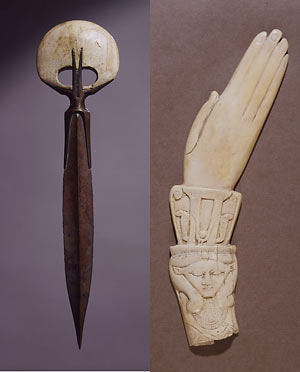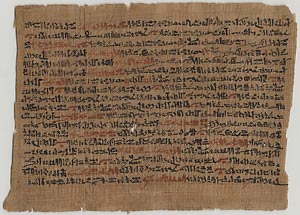UC Berkeley Press Release
New de Young museum features UC Berkeley contributions
BERKELEY – When the new M.H. de Young Museum in San Francisco's Golden Gate Park opens Saturday (Oct. 15), it will feature contributions by the University of California, Berkeley - on the grounds outside and in a major exhibit inside.
The landscaping of the nearly five acres surrounding the public art museum is the handiwork of Walter Hood, an award-winning UC Berkeley professor of landscape architecture and environmental planning.
 Among the artifacts on exhibit at the new de Young Museum are a bronze and ivory dagger and an ivory clapper, both from Egypt's 18th dynasty (1550-1295 B.C.). The pieces, on loan from Berkeley's Hearst Museum of Anthropology, were discovered in Deir el-Ballas by George Reisner, an archaeologist hired by Phoebe Hearst. (Photos courtesy the Hearst Museum of Anthropology) |
Meanwhile, an exhibit on the female pharaoh Hatshepsut reflects consultation by Cathleen Keller, a UC Berkeley associate professor of Near Eastern Studies.
That exhibit also includes a piece of ancient medical papyri from The Bancroft Library's Center for the Tebtunis Papyri, as well as an ancient bronze and ivory dagger and an ivory clapper musical instrument excavated from Southern Egypt around the turn of the center for what today is UC Berkeley's Phoebe Apperson Hearst Museum of Anthropology.
The museum's new landscaping, said Hood, changes how the museum, demolished after structural damage in the 1989 Loma Prieta earthquake, relates with the park surrounding it and creates a hybrid of a public park and a public museum.
The project includes the 35,000-square-foot Barbro Osher sculpture garden and terrace, and the 47,500-square-foot George Marcus children's garden that includes a "fog bog." It also retains its historic 100-year-old palm trees, the original sphinx sculptures that graced the entrance of the museum, along with cypress, pine and redwood trees, Australian tree ferns and eucalyptus trees in planters inside the museum.
Hood said the plants he chose break the pattern of the landscaping leading to the Pool of Enchantment at the side of copper-clad museum.
The "Hatshepsut: From Queen to Pharoah" exhibit celebrates the princess daughter of Thutmose I, the first Egyptian king of the early 18th dynasty. Keller said she was a key figure in Egyptian history because of her unusually long reign -- from 1479 to 1458. When her husband and half-brother Thutmose II died, the then-queen was appointed regent to oversee him in place of the young child's mother. While still in her 20s, she effectively positioned herself as Egypt's newest leader, naming herself pharaoh in 1473.
 A leaf from the Hearst medical papyrus from the early 18th dynasty during the joint reign of Hatshepsut and Thutmose III, acquired by George Reisner from a local resident in 1901. (Courtesy the Bancroft Library) |
After that, Keller said, she was depicted in statues and other iconic representations as male, reflecting the patriarchal society and association of power with being male.
For centuries, scholars maintained that because Hatshepsut was a woman, she was incapable of furthering her own ambitions, "but I think it's pretty clear that wasn't the case," Keller said.
The queen's tenure was known as a period of peace, great art and prosperity.
Keller worked on the exhibit with former UC Berkeley Ph.D. students in Near Eastern Studies; Catharine Roehrig, curator in the department of Egyptian art at the Metropolitan Museum of Art in New York City; and Renée Dreyfus, curator of ancient art and interpretation with the Fine Arts Museums of San Francisco.
Numerous museums contributed pieces to the exhibit, including the Egyptian Museum in Cairo, the Louvre, The British Museum, and the Hearst Museum, among others.
The nearly 300 exhibit items include statuary, furnishings, jewelry and other decorative arts. Keller noted that in a life-size relief in which Hatshepsut is dressed in female garb but a wears a male headdress adornment, "the expression on her face is riveting."
The exhibit, which has been years in the making, blends the latest scholarship on Hatshepsut with historical and social data about the era when she reigned. An audio tour, in which Keller is one of the guides, features a musical score.
In addition, the exhibit features an extensive, 600-page catalogue with contributions from top scholars.
Admission to the de Young is $15 for adults, $12 for seniors, $11 for youth ages 13-17. Children 12 and under are free. There is a $5 surcharge for the Egyptian exhibit. Tickets for the show, which runs through Feb. 5, 2006, can be bought in advance through www.thinker.org .
The museum is free the first Tuesday of each month.

